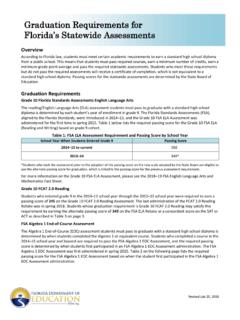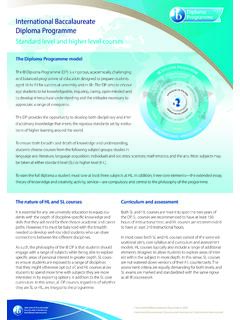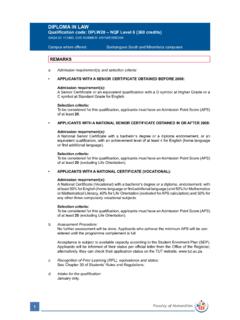Transcription of NFPA 1001 Standard - Jones & Bartlett Learning
1 Chapter PretestsInteractivitiesHot Term ExplorerWeb LinksReview ManualFireLearnSkill DrillsVoices of ExperienceFire MarksTeamwork TipsFire Fighter Safety TipsFire Fighter TipsCanadian PerspectivesHot TermsWrap-UpNFPA 1001 StandardFire Fighter Skill requirements . The ability to don personal protectiveclothing within one minute; doff personal protective clothing and prepare forreuse;hoist tools and equipment using ropes and the correct knot; tie a bowline,clove hitch, figure eight on a bight, half hitch, becket or sheet bend, and safetyknots; and locate information in departmental documents and Standard or codematerials. SCBA during emergency operations, given SCBA and other personalprotective equipment, so that the SCBA is correctly donned and activated withinone minute, the SCBA is correctly worn, controlled breathing techniques areused,emergency procedures are enacted if the SCBA fails, all low-air warningsare recognized, respiratory protection is not intentionally compromised, andhazardous areas are exited prior to air depletion.
2 (A)Requisite Knowledge. Conditions that require respiratory protection,uses, and limitations of SCBA, components of SCBA, donning procedures,breathing techniques, indications for and emergency procedures used withSCBA, and physical requirements of the SCBA (B)Requisite Skills. The ability to control breathing, replace SCBA aircylinders, use SCBA to exit through restricted passages, initiate and completeemergency procedures in the event of SCBA failure or air depletion, and com-plete donning and checkladders, ventilation equipment, self-contained breathingapparatus (SCBA),ropes, salvage equipment, and hand tools, given cleaningtools, cleaning supplies, and an assignment, so that equipment is clean andmaintained according to the manufacturer s or departmental guidelines, mainte-nance is recorded, and equipment is placed in a ready state or reported other-wise.
3 Fire Fighter certification at Level II, the Fire Fighter I shall meet the generalknowledge requirements in , the general skill requirements in , andthe job performance requirements defined in Sections through of thisstandard and the requirements defined in Chapter 5, Competencies for the FirstResponder at the Operational Level of nfpa 472, Standard for ProfessionalCompetence of Responders to Hazardous Materials Incidents. Additional nfpa StandardsNFPA 1404, Standard for Fire Service Respiratory Protection TrainingNFPA 1500, Standard on Fire Department Occupational Safety and HealthProgram nfpa 1582, Standard on Medical requirements for Fire Fighters andInformation for Fire Department PhysiciansNFPA 1971, Standard on Protective Ensemble for Structural FirefightingNFPA 1975, Standard on Station/Work Uniforms for Fire and EmergencyServicesNFPA 1976, Standard on Protective Ensemble for Proximity FirefightingNFPA 1977, Standard on Protective Clothing and Equipment for WildlandFirefightingNFPA 1981, Standard on Open-Circuit Self-Contained Breathing Apparatus forFire and Emergency ServicesNFPA 1982, Standard on Personal Alert Safety Systems (PASS)
4 Knowledge ObjectivesAfter completing this chapter, you will be able to: Discuss the educational, age, medical, physical fitness, and emergencymedical care requirements for becoming a fire fighter. Describe how standards and procedures, personnel, training, and equip-ment are related to the prevention of fire fighter injuries and deaths. List safety precautions you need to take during training, during emer-gency responses, at emergency incidents, at the fire station, and outsideyour workplace. Describe the protection provided by personal protective equipment (PPE). Explain the importance of standards for PPE. Describe the limitations of PPE. Describe how to properly maintain PPE. Describe the hazards of smoke and other toxic environments. Explain why respiratory protection is needed in the fire service.
5 Describe the differences between open-circuit breathing apparatus andclosed-circuit breathing apparatus. Describe the limitations associated with self-contained breathing apparatus (SCBA). List and describe the major components of SCBA. Explain the skip-breathing technique. Explain the safety precautions you should remember when using SCBA. Describe the importance of daily, monthly, and annual SCBA inspections. Explain the procedures for refilling SCBA cylinders. List the steps for donning a complete PPE ObjectivesAfter completing this chapter, you will be able to perform the following skills: Don approved personal protective clothing. Doff approved personal protective clothing. Don an SCBA from a seat-mounted bracket. Don an SCBA from a side-mounted compartment.
6 Don an SCBA from a storage case using the over-the-head method. Don an SCBA from a storage case using the coat method. Don a face piece. Doff an SCBA. Perform daily SCBA inspections. Perform monthly SCBA inspections. Replace an SCBA cylinder. Clean and sanitize an leaving the fire station to respond to a house fire, you don your personal protective clothing, board the apparatus, and fasten your seat belt. The fire is on the second floor. Yourofficer tells you and your partner to mount an interior attack, so you put on your self-containedbreathing apparatus (SCBA) and stretch a hose line to the house. Smoke fills the downstairs asyou make your way to the seat of the fire. You can feel the heat through your face piece and hearthe sounds of breaking glass and crackling flames.
7 You open the nozzle and direct a stream ofwater onto the fire to extinguish it. You continue to use your SCBA until the Safety Officerapproves working without How does your personal protective equipment keep you safe in this hostile environment?2. What are some of the limitations of your personal protective equipment?Fire Fighter QualificationsNot everyone can become a fire fighter. Those who dounderstand the vital mission of the fire department: to savelives and protect property. A fire fighter must be healthy andin good physical condition, assertive enough to enter a dan-gerous situation, but mature enough to work as a member ofa team . The job requires a person who hasthe desire to learn, the will to practice, and the ability toapply the skills of the trade.
8 A fire fighter is constantly learn-ing as the body of knowledge about fires increases and thetechnology used in fighting fires training and performance qualifications for fire fight-ers are specified in nfpa 1001, Standard for Fire FighterProfessional , education requirements ,medical requirements , and other criteria are establishedlocally. Age RequirementsMost career fire departments require that candidates be atleast 18 years of age, although some require a minimum ageof 21. Candidates should possess a valid driver s license,have a clean driving record, have no criminal record, and bedrug-free. Volunteer fire departments usually have different agerequirements, which often depend on insurance considera-tions. Some volunteer fire departments allow junior mem-bers to join at age 16, but restrict their activities until theyreach age 18.
9 Education RequirementsMost career fire departments require that applicants have atleast a high school diploma or equivalent. Some require can-didates to have more advanced college-level courses in a fire-or EMS-related field. All departments will require fire fight-ers who wish to be considered for promotion or extraresponsibility to take additional courses. Figure 2-1 Medical RequirementsBecause firefighting is both stressful and physically demand-ing, fire fighters must have a medical evaluation before train-ing begins. The medical evaluation will identify any medicalcondition or physical limitation that could increase the riskof injury or illness to the candidate or other fire requirements for fire fighters are specified in NFPA1582, Standard on Medical requirements for Fire Fighters andInformation for Fire Department Physicians.
10 Physical Fitness RequirementsPhysical fitness requirements are established to ensure thatfire fighters have the strength and stamina needed to per-form the tasks associated with firefighting and emergencyoperations. Several performance-testing scenarios have beenvalidated by qualified organizations. nfpa 1001 allows indi-Firefighting requires a special person. Figure 2-1 Fire Fighter Qualifications and Safety23cle collision involving an emergency vehicle .One study found that 27% of the fire fighters who died inthose incidents were ejected from the vehicle, which sug-gests that they were not using seatbelts. Fire fighters shouldnever overlook basic safety procedures, such as always fas-tening seat belts, especially during emergency responses.




